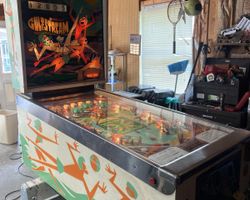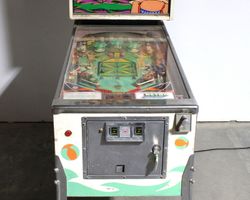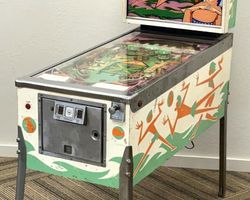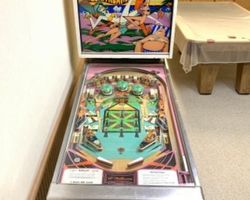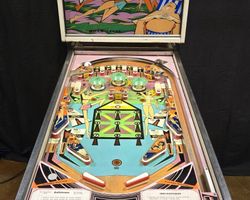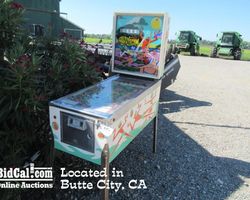Gulfstream
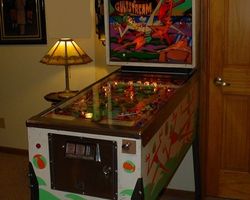
Average Prices: USD $200 to $700
Produced: October, 1972
Production Run: 4,175 units
Machine Type: Electro-mechanical
Players: 1
Design by: Norm Clark
Art by: Christian Marche
Williams Electronics, Incorporated released Gulfstream in May 1973, an electro-mechanical (EM) pinball machine that immersed players in a vibrant aquatic world. The machine’s theme revolves around water sports and beach leisure, a fitting backdrop for its engaging playfield design. Gulfstream was a collaboration between designer Norm Clark and artist Christian Marche. Clark, a prolific designer for Williams, was known for creating layouts that balanced accessibility with replay value. Marche’s distinctive artistic style, characterized by elongated figures often referred to as "pointy people," defined the visual identity of many Williams machines of the era, and Gulfstream is a prime example of his work.
The production of Gulfstream totaled 4,175 units, a solid run for an EM machine in the early 1970s. Its manufacturing process was split into two main phases. An initial sample run of 93 units began production on October 23, 1972, with the first units shipping in mid-December 1972. The main production run, consisting of 4,082 units, commenced on May 24, 1973, and concluded in late June 1973, with final shipments extending into July. This staggered production was a common practice, allowing manufacturers to fine-tune aspects before a broader release. Gulfstream was also notable for being one of the first Williams games to utilize their "gear" style of pop bumper cap, a minor yet distinct design evolution. Furthermore, it employed a "split bank" of relays, a system previously seen in multi-player games like Williams' 1971 Solids N Stripes, but here adapted for a single-player experience to track two separate playfield objectives. This engineering choice demonstrated Williams' commitment to refining the capabilities of EM systems.
Signature Features and Design
Gulfstream distinguishes itself with several key features that contribute to its play experience. Foremost among these is the "Magic Square" or tic-tac-toe grid centrally located on the playfield. This innovative system is activated by hitting specific targets and rollovers, offering multiple pathways to score and earn game enhancements. Another prominent element is Christian Marche's artwork. The “pointy people” style, featuring exaggerated, athletic figures engaged in various beach activities, creates a unified and energetic aesthetic. The bright, contrasting colors and dynamic composition of the playfield and backglass reinforce the upbeat, sporty theme.
The machine also leveraged technological advancements for its time. Gulfstream was equipped with DC-powered pop bumpers and flippers. This direct current application resulted in notably fast and powerful action, a characteristic often associated with later solid-state machines but present here in an EM design. This gave Gulfstream a more responsive feel than many of its contemporaries. The machine was convertible between "Replay" and "Add-A-Ball" modes, an operator-adjustable setting that allowed arcade owners to tailor the game's reward structure. In replay mode, achieving certain objectives awarded free games, while in add-a-ball mode, players could earn additional balls to continue their current game, extending playtime and adding a layer of strategic depth. These features collectively enhanced gameplay, offering both visual appeal and mechanical responsiveness that set Gulfstream apart.
Playfield and Mechanics
The Gulfstream playfield is designed for a dynamic and accessible game flow, centered around its unique scoring mechanisms. At the heart of the playfield lies the 3x3 "Magic Square" grid, which players aim to complete by hitting three standup targets and three rollover buttons strategically placed across the layout. Two kick-out holes are integrated into this system, often lighting for a "Special" or "Extra Ball" when three-in-a-row is achieved on the grid. Directly below the central grid is a prominent center target, a high-risk, high-reward shot that scores significant points, often 5,000 when lit, and contributes to advancing the grid, though it can also lead to outlanes.
The upper playfield is dominated by three powerful pop bumpers, which provide erratic and fast ball movement, contributing to the game's energetic pace. Two slingshots at the lower sides of the playfield deflect the ball back into the active area, maintaining momentum. The two flippers are positioned to offer a wide range of shots, including precise aims at the center target, bank shots off the upper arch, and strategic plays to activate the rollovers in the inlanes that spell "S-P-E-C-I-A-L." The overall design philosophy emphasizes continuous action and strategic target hitting over complex ramp shots or multi-level play, a common characteristic of EM machines. The artwork on the playfield seamlessly integrates the water sports theme, with stylized waves and beach elements guiding the player's eye and reinforcing the game’s aesthetic identity. The lighting system, while rudimentary by modern standards, effectively highlights active targets and scoring opportunities, guiding the player through the game's objectives.
Gameplay Dynamics
Gulfstream's gameplay mechanics are straightforward yet engaging, offering both immediate gratification and deeper strategic considerations. The primary objective revolves around the central "Magic Square" grid. Players aim to light three targets in a row, either horizontally, vertically, or diagonally. Completing a line often lights one of the two kick-out holes for an "Extra Ball" or "Special." A more challenging objective is to light all four corner targets of the grid. This "4 Corners" achievement is highly rewarding, typically granting multiple replays or additional balls depending on the machine’s operator settings, making it a lucrative goal that adds longevity to a game.
Beyond the grid, players are encouraged to spell out "S-P-E-C-I-A-L" by hitting rollover buttons located in the inlanes and other areas. Completing this sequence consistently awards an extra ball, providing another avenue for extended play. The center target, positioned directly in front of the "Magic Square," serves as a high-value shot. Successfully hitting it when lit not only awards substantial points but can also advance progress on the grid. However, its central location makes it a dangerous shot, prone to direct drains if not executed precisely. Strategies often involve a combination of precise aiming for the center target and opportunistic shots into the pop bumper area to gain points and activate random grid elements, followed by controlled shots to complete lines or spell "SPECIAL." The add-a-ball mode, where available, allows players to accumulate a significant number of balls, shifting the focus from high scores to extended play sessions and the pursuit of multiple "4 Corners" awards. This design ensures that Gulfstream maintains appeal for both casual players and those seeking to master its nuances.
Reception and Legacy
Gulfstream generally garnered positive reception within the pinball community, particularly among enthusiasts of electro-mechanical machines. Its strengths frequently cited include its fast gameplay, an attribute often attributed to its DC-powered components, which lent a snappiness to the flippers and pop bumpers that felt advanced for an EM game. Many players commend its simple, accessible ruleset that makes it easy for newcomers to grasp, yet it offers enough strategic depth to keep experienced players engaged. The central tic-tac-toe grid, especially the "4 Corners" objective, is frequently highlighted as a standout feature, considered one of the more rewarding and well-implemented grid mechanics in pinball history. Christian Marche’s "pointy people" artwork is another significant talking point; while distinctive and generally praised for its vibrant aesthetic and thematic coherence, it is acknowledged that this unique style might not appeal to every individual.
However, Gulfstream is not without its points of critique. Some players, especially those accustomed to more complex modern machines, might find its simplicity lacking in long-term depth. The absence of a traditional bonus collection at the end of each ball is occasionally noted as a minor omission. As with many EM games, the machine’s performance is highly dependent on proper maintenance; a poorly tuned Gulfstream can suffer from unresponsive chimes or sluggish mechanics. While the chimes are generally appreciated for their classic Williams sound, a few describe them as "tinny" even when tuned. Despite these minor criticisms, Gulfstream holds a respected position in pinball history. It is often regarded as one of Williams' more engaging single-player EM offerings from the early 1970s. Its adoption of DC-powered components was a subtle step towards the faster play often found in solid-state games, and its well-executed tic-tac-toe mechanic influenced subsequent games that sought to incorporate similar grid-based objectives. Gulfstream remains a representative example of a successful electro-mechanical design that prioritized engaging gameplay and an inviting theme.
Sponsored Links
 Ebay Listings
Ebay Listings
 Auction Results
Auction Results
| Cost | Location | Date |
|---|---|---|
| USD $2,000 |  Ohio, United States Ohio, United States |
13 August, 2025 |
| USD $1,125 |  Washington, United States Washington, United States |
11 August, 2025 |
| USD $2,995 |  California, United States California, United States |
31 March, 2025 |
| USD $450 |  Indiana, United States Indiana, United States |
04 October, 2024 |
| USD $495 |  Pennsylvania, United States Pennsylvania, United States |
21 September, 2024 |
| USD $360 |  Pennsylvania, United States Pennsylvania, United States |
21 September, 2024 |
| USD $502 |  California, United States California, United States |
10 September, 2024 |
| USD $375 |  Maryland, United States Maryland, United States |
27 June, 2024 |
| GBP £265 |  Okehampton, United Kingdom Okehampton, United Kingdom |
25 February, 2024 |
| USD $449 |  California, United States California, United States |
18 February, 2024 |


Private Policy · Search Website · Contact Us
As an eBay Partner, we may earn a commission from qualifying purchases made through links on this site, at no additional cost to you.
All trademarks and copyrighted materials remain property of their respective owners. All other content copyright 2007 - 2025 Pinpedia.

